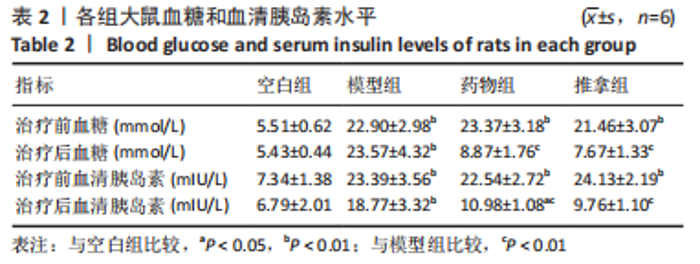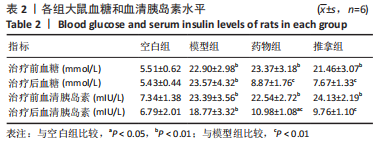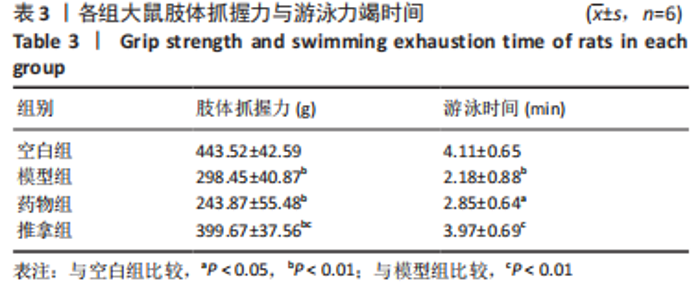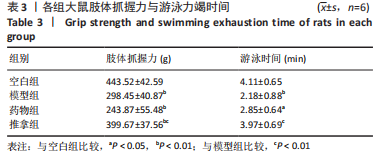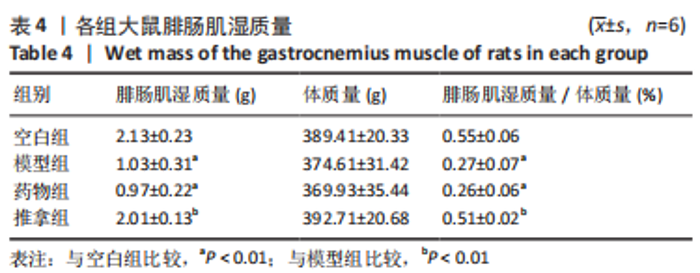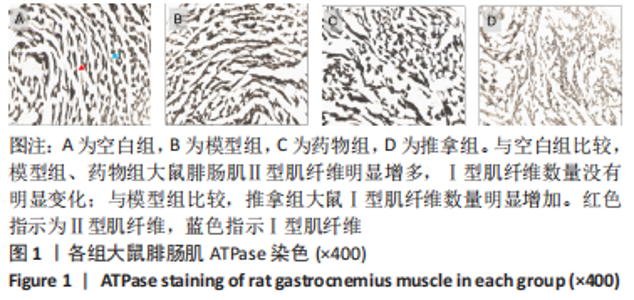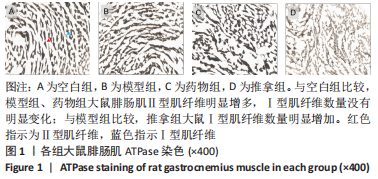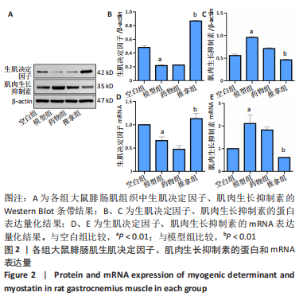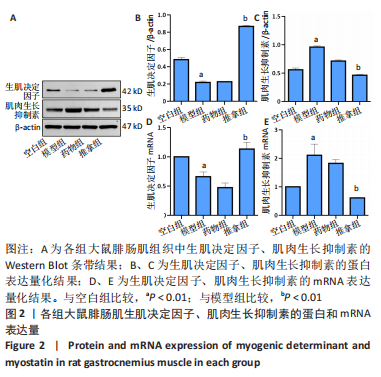Chinese Journal of Tissue Engineering Research ›› 2023, Vol. 27 ›› Issue (35): 5628-5633.doi: 10.12307/2023.891
Previous Articles Next Articles
Effects of skeletal muscle massage on skeletal muscle function and conversion of skeletal muscle fiber types in type 2 diabetic rats
Meng Meng1, 2, Hu Guanyu3, Wu Xingquan1, Cong Deyu1
- 1Affiliated Hospital of Changchun University of Chinese Medicine, Changchun 130021, Jilin Province, China; 2Changchun University of Chinese Medicine, Changchun 130117, Jilin Province, China; 3The Third Affiliated Hospital of Southern Medical University, Guangzhou 510630, Guangdong Province, China
-
Received:2022-10-25Accepted:2022-12-09Online:2023-12-18Published:2023-06-02 -
Contact:Cong Deyu, Chief physician, Affiliated Hospital of Changchun University of Chinese Medicine, Changchun 130021, Jilin Province, China -
About author:Meng Meng, MD, Attending physician, Affiliated Hospital of Changchun University of Chinese Medicine, Changchun 130021, Jilin Province, China; Changchun University of Chinese Medicine, Changchun 130117, Jilin Province, China -
Supported by:National Natural Science Foundation of China, No. 82274673 (to CDY)
CLC Number:
Cite this article
Meng Meng, Hu Guanyu, Wu Xingquan, Cong Deyu. Effects of skeletal muscle massage on skeletal muscle function and conversion of skeletal muscle fiber types in type 2 diabetic rats[J]. Chinese Journal of Tissue Engineering Research, 2023, 27(35): 5628-5633.
share this article
Add to citation manager EndNote|Reference Manager|ProCite|BibTeX|RefWorks
| [1] IZZO A, MASSIMINO E, RICCARDI G, et al. A Narrative Review on Sarcopenia in Type 2 Diabetes Mellitus: Prevalence and Associated Factors. Nutrients. 2021; 13(1):183. [2] 中华医学会老年医学分会老年康复学组,肌肉衰减综合征专家共识撰写组. 肌肉衰减综合征中国专家共识(草案)[J].中国综合临床,2018,34(3):193-199. [3] 张艳,何瑞波,王庆博,等.不同负荷量有氧运动对肥胖大鼠骨骼肌炎症反应和胰岛素信号途径的影响及机制[J].中国组织工程研究,2023,27(8): 1237-1244. [4] 谢宁,张凯艺,阮进学,等.Glut4突变调控脂肪重分布及肌纤维重塑的机制研究[J].畜牧兽医学报,2021,52(9):2464-2474. [5] 籍冬冬,焦欣,汤啟欢,等.推拿揉法现代研究进展[J].按摩与康复医学, 2017,8(8):6-8. [6] 王先滨,杨续艳,王之虹.通经调脏推拿法治疗痰湿郁阻型2型糖尿病临床研究[J].针灸临床杂志,2017,33(6):36-38. [7] 赵永军,张育民,郭艳花.抗阻运动与推拿防治骨骼肌衰减征研究进展[J].中国老年学杂志,2017,37(2):509-513. [8] 吴兴全.运腹通经推拿法改善肥胖2型糖尿病大鼠胰岛素抵抗的作用机制研究[D].长春:长春中医药大学,2018. [9] KUREK JM, KRÓL E, STANIEK H, et al. Steviol Glycoside, L-Arginine, and Chromium (Ⅲ) Supplementation Attenuates Abnormalities in Glucose Metabolism in Streptozotocin-Induced Mildly Diabetic Rats Fed a High-Fat Diet. Pharmaceuticals (Basel). 2022;15(10):1200. [10] AHMED YM, ORFALI R, ABDELWAHAB NS, et al. Partial Synthetic PPARƳ Derivative Ameliorates Aorta Injury in Experimental Diabetic Rats Mediated by Activation of miR-126-5p Pi3k/AKT/PDK 1/mTOR Expression. Pharmaceuticals (Basel). 2022; 15(10):1175. [11] 钟文.参芪复方防治糖尿病相关性肌少症的作用及机制研究[D].成都:成都中医药大学,2018. [12] 李忠仁.实验针灸学[M].北京:中国中医药出版社,2007:273-274. [13] GARCIA NF, MORAES C, REBELO MA, et al. Strength training with and without arteriovenous blood flow restriction improves performance, regardless of changes in muscle hypertrophy, in Wistar rats. An Acad Bras Cienc. 2022;94(suppl 3):e20201147. [14] YANG W, GAO B, QIN L, et al. Puerarin improves skeletal muscle strength by regulating gut microbiota in young adult rats. J Orthop Translat. 2022;35:87-98. [15] GODOY G, TRAVASSOS PB, ANTUNES MM, et al. Strenuous swimming raises blood non-enzymatic antioxidant capacity in rats. Braz J Med Biol Res. 2022;55:e11891. [16] FARIA VS, MANCHADO-GOBATTO FB, SCARIOT PPM, et al. Melatonin Potentiates Exercise-Induced Increases in Skeletal Muscle PGC-1α and Optimizes Glycogen Replenishment. Front Physiol. 2022;13:803126. [17] FITTS RH, RILEY DR, WIDRICK JJ. Physiology of a microgravity environment invited review: microgravity and skeletal muscle. J Appl Physiol (1985). 2000;89(2):823-839. [18] MULAVARA AP, PETERS BT, MILLER CA, et al. Physiological and Functional Alterations after Spaceflight and Bed Rest. Med Sci Sports Exerc. 2018;50(9):1961-1980. [19] FONSECA-PÉREZ D, ARTEAGA-PAZMIÑO C, MAZA-MOSCOSO CP, et al. Food insecurity as a risk factor of sarcopenic obesity in older adults. Front Nutr. 2022;9: 1040089. [20] CRUZ-JENTOFT AJ, BAHAT G, BAUER J, et al. Sarcopenia: revised European consensus on definition and diagnosis. Age Ageing. 2019;48(4):601. [21] 陈昱圻,郭昌龙,袁国红,等.衰老个体骨骼肌卫星细胞的研究进展[J].中国老年学杂志,2022,42(17):4354-4360. [22] BATAILLE S, CHAUVEAU P, FOUQUE D, et al. Myostatin and muscle atrophy during chronic kidney disease. Nephrol Dial Transplant. 2021;36(11):1986-1993. [23] KOBAYASHI M, KASAMATSU S, SHINOZAKI S, et al. Myostatin deficiency not only prevents muscle wasting but also improves survival in septic mice. Am J Physiol Endocrinol Metab. 2021;320(1):E150-E159. [24] LEE SJ, LEHAR A, MEIR JU, et al. Targeting myostatin/activin A protects against skeletal muscle and bone loss during spaceflight. Proc Natl Acad Sci U S A. 2020; 117(38):23942-23951. [25] MATSUDA T, SUZUKI H, SUGANO Y, et al. Effects of Branched-Chain Amino Acids on Skeletal Muscle, Glycemic Control, and Neuropsychological Performance in Elderly Persons with Type 2 Diabetes Mellitus: An Exploratory Randomized Controlled Trial. Nutrients. 2022;14:3917. [26] LEE EJ, AHMAD SS, LIM JH, et al. Interaction of Fibromodulin and Myostatin to Regulate Skeletal Muscle Aging: An Opposite Regulation in Muscle Aging, Diabetes, and Intracellular Lipid Accumulation. Cells. 2021;10:2083. [27] CHEN L, NELSON DR, ZHAO Y, et al. Relationship between muscle mass and muscle strength, and the impact of comorbidities: a population-based, cross-sectional study of older adults in the United States. BMC Geriatr. 2013;13:74. [28] LEMES ÍR, FERREIRA PH, LINARES SN, et al. Resistance training reduces systolic blood pressure in metabolic syndrome: a systematic review and meta-analysis of randomised controlled trials. Br J Sports Med. 2016;50(23):1438-1442. [29] MITCHELL WK, WILLIAMS J, ATHERTON P, et al. Sarcopenia, dynapenia, and the impact of advancing age on human skeletal muscle size and strength; a quantitative review. Front Physiol. 2012;3:260. [30] FABBRI E, ZOLI M, GONZALEZ-FREIRE M, et al. Aging and Multimorbidity: New Tasks, Priorities, and Frontiers for Integrated Gerontological and Clinical Research. J Am Med Dir Assoc. 2015;16(8):640-647. [31] MERZ KE, TUNDUGURU R, AHN M, et al. Changes in Skeletal Muscle PAK1 Levels Regulate Tissue Crosstalk to Impact Whole Body Glucose Homeostasis. Front Endocrinol (Lausanne). 2022;13:821849. [32] Egan DF, Shackelford DB, Mihaylova MM, et al. Phosphorylation of ULK1 (hATG1) by AMP-activated protein kinase connects energy sensing to mitophagy. Science. 2011;331(6016):456-461. [33] SCHIAFFINO S, DYAR KA, CICILIOT S, et al. Mechanisms regulating skeletal muscle growth and atrophy. FEBS J. 2013;280(17):4294-4314. [34] REN Q, CHEN S, CHEN X, et al. An Effective Glucagon-Like Peptide-1 Receptor Agonists, Semaglutide, Improves Sarcopenic Obesity in Obese Mice by Modulating Skeletal Muscle Metabolism. Drug Des Devel Ther. 2022;16:3723-3735. [35] SANCHEZ AM, CSIBI A, RAIBON A, et al. AMPK promotes skeletal muscle autophagy through activation of forkhead FoxO3a and interaction with Ulk1. J Cell Biochem. 2012;113(2):695-710. [36] CAI Y, ZHAN H, WENG W, et al. Niclosamide ethanolamine ameliorates diabetes-related muscle wasting by inhibiting autophagy. Skelet Muscle. 2021;11(1):15. [37] KINOSHITA H, MIYAKOSHI N, KASUKAWA Y, et al. Effects of eldecalcitol on bone and skeletal muscles in glucocorticoid-treated rats. J Bone Miner Metab. 2016; 34:171-178. [38] OHIRA T, TERADA M, KAWANO F, et al. Region-specific responses of adductor longus muscle to gravitational load-dependent activity in Wistar Hannover rats. PLoS One. 2011;6:e21044. [39] LEE YG, WOO H, CHOI C, et al. Supplementation with Vitis vinifera Jingzaojing Leaf and Shoot Extract Improves Exercise Endurance in Mice. Nutrients. 2022; 14(19):4033. [40] CALLAHAN MJ, PARR EB, SNIJDERS T, et al. Skeletal Muscle Adaptive Responses to Different Types of Short-Term Exercise Training and Detraining in Middle-Age Men.Med Sci Sports Exerc.2021;53:2023-2036. [41] LONG DE, PECK BD, TUGGLE SC, et al. Associations of muscle lipid content with physical function and resistance training outcomes in older adults: altered responses with metformin. Geroscience. 2021;43:629-644. [42] WALTON RG, DUNGAN CM, LONG DE, et al. Metformin blunts muscle hypertrophy in response to progressive resistance exercise training in older adults: A randomized, double-blind, placebo-controlled, multicenter trial: The MASTERS trial. Aging Cell. 2019;18:e1303. |
| [1] | Liu Yang, Wu Lianqing. Therapeutic efficacy of massage versus instrument-assisted soft tissue mobilization in patients with lateral epicondylitis of the humerus [J]. Chinese Journal of Tissue Engineering Research, 2024, 28(26): 4226-4233. |
| [2] | Peng Zhihua, Pan Junxi, Feng Qinghui, Tian Tianzhao, Zhang Sheng, Li An, Cai Yingfeng. The causal relationship between blood lipids and muscle atrophy based on Mendelian randomization analysis of two samples [J]. Chinese Journal of Tissue Engineering Research, 2024, 28(23): 3699-3703. |
| [3] | Kong Jianda, Xie Yingao, Chen Shijuan, Zhu Lei. Blood flow restriction training interventions for sarcopenia in older adults: biological mechanisms and proposed application protocols [J]. Chinese Journal of Tissue Engineering Research, 2024, 28(23): 3743-3750. |
| [4] | Xie Peng, Zhang Jiang, Deng Xiaolei, Wei Bo, Hou Decai. A systematic review of mouse model construction for sarcopenia [J]. Chinese Journal of Tissue Engineering Research, 2024, 28(2): 263-266. |
| [5] | Long Yi, Yang Jiaming, Ye Hua, Zhong Yanbiao, Wang Maoyuan. Extracellular vesicles in sarcopenic obesity: roles and mechanisms [J]. Chinese Journal of Tissue Engineering Research, 2024, 28(2): 315-320. |
| [6] | Wang Ji, Hu Li, Yang Zhongya, Han Peng. A cross-sectional survey on the prevalence and risk factors of sarcopenia in the elderly in some areas of the Yunnan-Guizhou Plateau [J]. Chinese Journal of Tissue Engineering Research, 2024, 28(14): 2197-2201. |
| [7] | Wang Ji, Zhang Min, Yang Zhongya, Zhang Long. A review of physical activity intervention in type 2 diabetes mellitus with sarcopenia [J]. Chinese Journal of Tissue Engineering Research, 2023, 27(8): 1272-1277. |
| [8] | Gu Peng, Pu Bin, Chen Junbang, Yue Dan, Xin Qiao, Zeng Zhanpeng, Zheng Xiaohui. Correlation between new sarcopenia index and bone mineral density in postmenopausal patients with type 2 diabetes mellitus [J]. Chinese Journal of Tissue Engineering Research, 2023, 27(31): 5009-5014. |
| [9] | Liu Baijie, Zhou Honghai, He Xinyu, Qin Hongtu, Chen Longhao, Tian Junming, Lu Qingwang. Three-dimensional finite element method to analyze biomechanical characteristics of spinal manipulation [J]. Chinese Journal of Tissue Engineering Research, 2023, 27(27): 4385-4392. |
| [10] | Shen Lianwei, Wang Wei. Radial extracorporeal shockwave combined with resistance exercise for treating senile primary sarcopenia [J]. Chinese Journal of Tissue Engineering Research, 2023, 27(11): 1647-1652. |
| [11] | Lü Qianyi, Chen Xinyi, Zheng Huie, He Haolong, Li Qilong, Chen Chutao, Tian Haomei. Stress and displacement of normal lumbar vertebra and posterior structure with different elbow pressing methods [J]. Chinese Journal of Tissue Engineering Research, 2022, 26(9): 1346-1350. |
| [12] | Kong Yamin, Yan Juntao, Ma Bingxiang, Li Huawei. Massage vibration intervenes with MyoD expression and proliferation and differentiation of muscle satellite cells in rats with sciatic nerve injury [J]. Chinese Journal of Tissue Engineering Research, 2022, 26(8): 1160-1166. |
| [13] | Zheng Zhenquan, Rong Jiesheng. Sarcopenia: age-related muscle mass loss and functional declines [J]. Chinese Journal of Tissue Engineering Research, 2022, 26(5): 792-797. |
| [14] | Wang Tiegang, Pan Lina, Wang Hai, Yang Tiansong, Sun Zhongren. Therapeutic effect of Rod Tuina combined with electrical stimulation biofeedback on stress urinary incontinence in adult women: changes in surface electromyography values of pelvic floor muscles [J]. Chinese Journal of Tissue Engineering Research, 2022, 26(35): 5693-5699. |
| [15] | Xu Junjie, Li Yehai, Liu Qing, Wang Jian, Liang Junsheng, Liu Hefeng, Dai Ru. Comparison of fracture healing and complications after internal fixation in patients with intertrochanteric fracture with and without concomitant sarcopenia [J]. Chinese Journal of Tissue Engineering Research, 2022, 26(15): 2342-2346. |
| Viewed | ||||||
|
Full text |
|
|||||
|
Abstract |
|
|||||
